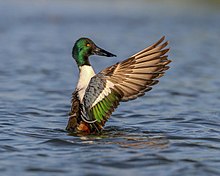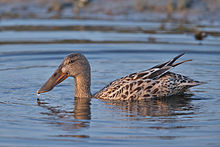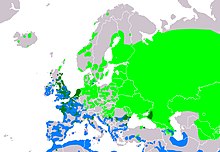| Northern shoveler Temporal range:
| |
|---|---|

| |
| Male | |

| |
| Female | |
| Scientific classification | |
| Domain: | Eukaryota |
| Kingdom: | Animalia |
| Phylum: | Chordata |
| Class: | Aves |
| Order: | Anseriformes |
| Family: | Anatidae |
| Genus: | Spatula |
| Species: | S. clypeata
|
| Binomial name | |
| Spatula clypeata (Linnaeus, 1758)
| |

| |
| Range distribution of northern shoveler Breeding Resident Passage Non-breeding Vagrant (seasonality uncertain) Extant & Introduced (seasonality uncertain)
| |

| |
| European distribution. Breeding Resident Non-breeding
| |
| Synonyms | |
|
Anas clypeata Linnaeus, 1758 | |
The northern shoveler (/ˈʃʌvələr/; Spatula clypeata), known simply in Britain as the shoveler,[2] is a common and widespread duck. It breeds in northern areas of Europe and across the Palearctic and across most of North America,[3] wintering in southern Europe, the Indian subcontinent, Southeast Asia, Central America, the Caribbean, and northern South America. It is a rare vagrant to Australia. In North America, it breeds along the southern edge of Hudson Bay and west of this body of water, and as far south as the Great Lakes west to Colorado, Nevada, and Oregon.[4][5]
The northern shoveler is one of the species to which the Agreement on the Conservation of African-Eurasian Migratory Waterbirds (AEWA) applies.[6] The conservation status of this bird is Least Concern.[1]
- ^ a b BirdLife International (2019). "Spatula clypeata". IUCN Red List of Threatened Species. 2019: e.T22680247A153875944. doi:10.2305/IUCN.UK.2019-3.RLTS.T22680247A153875944.en. Retrieved 12 November 2021.
- ^ "The British List" (PDF). British Ornithologist's Union. 30 June 2021. Retrieved 8 July 2021.
- ^ Cite error: The named reference
Clementswas invoked but never defined (see the help page). - ^ Cite error: The named reference
Floydwas invoked but never defined (see the help page). - ^ Cite error: The named reference
Dunnwas invoked but never defined (see the help page). - ^ Cite error: The named reference
AEWAwas invoked but never defined (see the help page).

